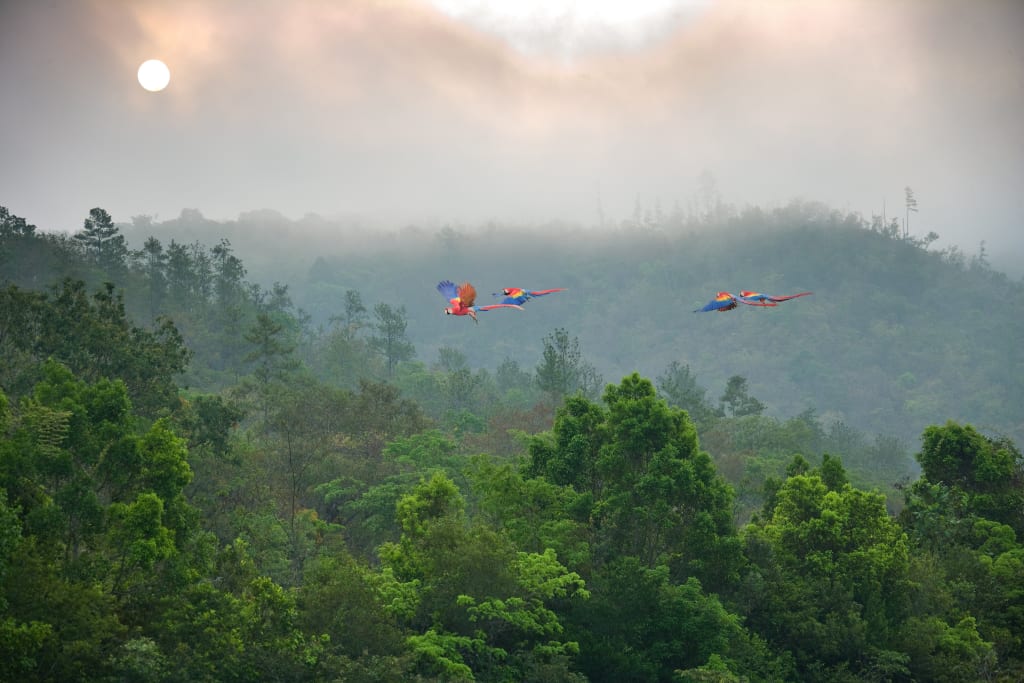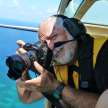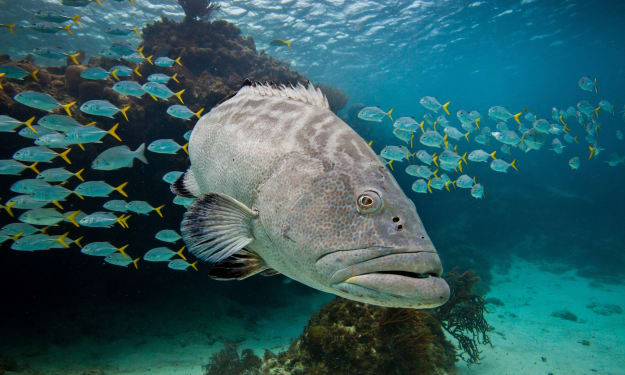
View print sizes for Chiquibul Macaws at Dawn by Tony Rath:
Story Behind the Photograph: Chiquibul Macaws at Dawn
For me, the Chiquibul forest is always best before dawn.
I awake to the chirps of the crickets, whine of katydids and desperate croak of a frog that has yet to find a mate; the chorus of birdsong begins with a single instrument - the mournful notes of the tinamou - but soon swells to the level of an orchestra with warblers, wrens, woodpeckers and parakeets joining in. The roar of howler monkeys plays to the nearby rush of rapids at the concrete Quacamayo Bridge over the Macal River. As I heat the water for my morning coffee by headlamp and set up my tripod and wide-angle lens, I watch for the sun to burn through the fog covering the hills, and bask in the natural music of the jungle waking up.
The Macal River forms a unique barrier between ecosystems. On the northern side of the river lies the Pine Ridge, a habitat characterized by highly leached, poorly drained soils, and dominated by a single species: the Carribbean Pine. Yet, just across the river to the south flourishes the most diverse land habitat in the country, the Chiquibul Forests of Western Belize.
Many endangered animals call the Chiquibul home. These include the largest wildcat in Central America, the jaguar; the largest land mammal in Central America, the tapir; and the acrobatic and shy spider monkey.
But the loudest, flashiest, and rarest of the Chiquibul’s endangered creatures is the brilliant scarlet macaw, whose contribution to the delicate symphony of morning birdsong is a raucous - almost bombastic - squawk far in the distance. One of the largest remaining populations of these riotously large parrots are found in the deciduous trees along the major rivers of the Chiquibul - including the Macal - often in prodigious and noisy groups. They make their nests high off the ground in tall trees - living or dead - to protect from roving predators.
The worst of these predators is human. Capture by Guatemalan poachers is the major threat to the survival of scarlet macaws in Belize, and is a substantial cause of nest failure in the Chiquibul Forest. Fortunately, since 2010, Belizean NGOs have been protecting the nests, and hand raising recovered poached birds for release in the wild.
Due to these conservation efforts, the population of macaws in Belize has stabilized enough that the birds are now venturing out of the Chiquibul, populating other habitats and regions of Belize.
As I sip my steaming coffee beside the river, a white orb breaks through the mist and seconds later highlights a quartet of red, blue and yellow feathers barnstorming across the valley. These birds in the photo are flying north, from the rich tropical forests of the Chiquibul, over the Macal River and into the Pine Ridge perhaps seeking new feeding or breeding grounds.
These macaws provide witness to the Chiquibul as the great provider of life, a breeding ground and fountain of biological wealth that is shared with the rest of Belize. That such a marvelous and mysterious habitat still exists and its tenants still thrive is, for the moment at least, a reason for all Belizeans to rejoice and be proud.
About Untamed Photographer
Untamed Photographer is an online art gallery that brings together wildlife photography and stories from a range of international environmental artists, both emerging and established.
Structured as an online marketplace, Untamed Photographer offers a selection of handpicked, limited-edition works of art, alongside the photographers’ compelling stories of what occurred in the wild to get the shot. The exclusive limited-edition pieces are printed in Miami and come with an artist-signed certificate of authenticity from their respective worldwide locations.
The Nature Trust of the Americas (NTOTA) was founded with the mission to give back. While building awareness for NTOTA’s causes, the founders met talented nature photographers who are passionate not only about photography, but also about saving the planet. Their life’s work and stories are inspiring, and their art, passion and stories deserve to be shared on a platform that benefits the environmental causes they are dedicated to.
Just as the photographers preserve the beauty of the planet in their art, Untamed Photographer is dedicated to preserving the planet for the future. All profits from photographs go to Untamed Photographer's two pillars: the artists and causes that protect the environment, ecosystems, and wildlife.
About the Photographer: Tony Rath
Tony Rath is a writer, photojournalist and commercial photographer based along the Caribbean Sea in the picturesque village of Dangriga, Belize.
Tony attended the United States Air Force Academy, where he flew gliders above the Rocky Mountains and trained with Navy SEALS in San Diego. After leaving the military he studied toward a marine biology degree, working as a technician, diver, and underwater photographer for Scripps Institution of Oceanography and the Smithsonian Institution’s Marine Research Station in Belize.
At age 23, Tony took early retirement and for 7 years sailed as either first mate or captain across the Atlantic (twice), Mediterranean, North Sea and the Caribbean. While sailing, he visited over 35 countries, more than 250 ports of call, and sailed over 30,000 miles. Throughout his adventures, Tony always carried a camera, turning professional in the mid-1990s.
Tony's photography is on display at the Smithsonian Institution in Washington, D.C. and featured in the Minnesota Science Museum’s award-winning traveling Maya exhibit. His images have been published in hundreds of magazines and books, such as BBC Wildlife, National Geographic Traveler, Islands, and Smithsonian Magazine. Tony's clients include the United Nations, Government of Belize, and many international environmental NGOs.
Living in Belize since 1988, he documents the natural environment and cultures of his adopted country, above and below water. He has published two photo books on Belize.
Tony volunteers his skills and imagery to countless educational and NGOs to promote culture and conservation. In 2015 he presented one of the first TEDx Talks in Belize.
While known for his natural history imagery, he also covers lifestyle, travel, portraits and culture throughout Belize and neighboring countries.
About the Creator
Tony Rath
Tony Rath is a writer photojournalist based along the shore of the Caribbean Sea in the picturesque town of Dangriga, Belize.
http://www.tonyrath.com
Facebook: BelizePhotography
Twitter: trphoto
Instagram: tonyrath








Comments
There are no comments for this story
Be the first to respond and start the conversation.